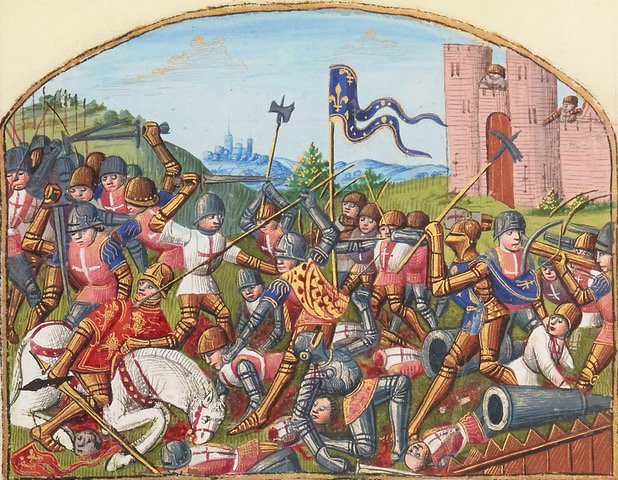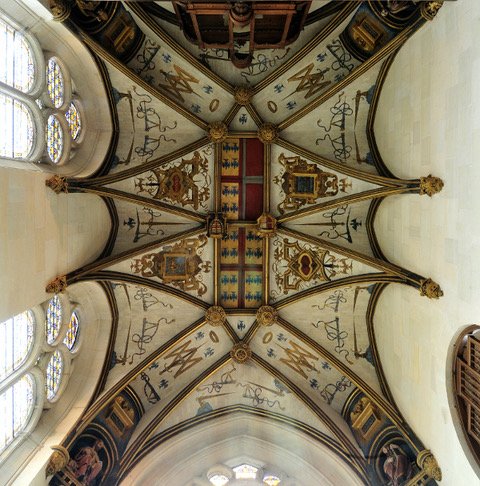Whose side are you on?
The art and artifice of renaissance affiliation
Le Blason des Temps Nouveau, Musée National de la Renaissance
I went on a press junket with a small but amiable group of journalists and professors/teachers. To a place I have been before, both on my own and with another group, like this one. I was back at the Chateau d’Écouen, the Musée National de la Renaissance. Although we had been invited months in advance, I was expecting the trip to be cancelled at the last minute. Because French petrol refinery workers were on strike. And most gas stations in France were either closed or had long lines of angry drivers in front of them. And as luck would have it, the public transport workers were scheduled to strike the day of our trip. I imagined that even if the bus had enough gas to take us to the chateau and get us back, it was possible that the Paris metros would not be running and I wouldn’t get to the meeting point. As it turned out, the metros were running, the bus had gas and our junket happened as planned.
Last time I was at the Chateau d’Écouen, it was for an exhibition on glass objects from Murano, Italy. Experts explained how they were able to distinguish glass objects made in Murano from glass objects created elsewhere in the Murano style. And how they determined if a glass object was made in the 16th century or was a forgery or fake created centuries later. The glass beautiful. The explanations exhaustive.
This time, the subject is heraldry, coats-of-arms. There were objects on loan from other French museums, but the chateau itself, (Figure 1) built between 1539 and 1555 for Anne de Montmorency, the commander of the French army for Francois I and then for his son, Henri II, was perfect for such an exhibition. Filled as it is with sculptural and painted decorations and the collection of Renaissance objects it inherited from the Musée du Cluny when that museum became a medieval-only one.
Figure 1. Chateau d’Écouen, facade
If you are wondering about Anne de Montmorency’s first name - wonder no more. When he was born, in 1493, (Figure 2) Anne was an epicene name, that is, a name which was equally suitable for males and females. Since Queen Anne of Brittany was his godmother, Anne was as good a name as any, maybe better. And since the chateau was built for him, his coat of arms are everywhere, embellishing everything.
Figure 2. Anne de Montmorency, portrait, Corneille de Lyon (artist)
The idea for this exhibition, from what I could understand, came from a young college instructor who brought his students to the chateau looking for all the coats-of-arms they could find. Herewith a brief (promise) definition of what they were looking for during their Where’s Waldo Renaissance Romp. (Figures 3, 4)
Figure 3. Window at Chateau d’Écouen with coat of arms
Figure 4. Interior Courtyard of Chateau d'ARgy
Beginning in the medieval period, soldiers and knights wore surcoats, (French for overcoat, aka over the coat) long, loose, often sleeveless cloth tunics over their armor to protect them from the sun’s heat. And to identify them since the surcoats were decorated with a coat of arms. The same coat of arms that was on every combatant’s banner and shield. In the thick of battle, it was the only way to distinguish friend from foe. (Figure 5) At battle’s end, it was the only way that heralds, making their way through a battlefield strewn with dead bodies, could make a body count. And determine which side had won.
Figure 5. Bataille de Castillon, (1453) SW France, manuscript miniature 1484
The most important part of the coat of arms is the shield or the escutcheon. That’s the central shape on which the colors and symbols are placed. (Figure 6) The elements that surround it are optional. Since they were the only way one ‘side’ could be identified from the other on a field of battle, the heraldic design on a knight’s shield had to be unique to his ‘side'.
Figure 6. Anne de Montmorency’s Coat of Arms (for whom Chateau d’Écoeun was built)
Obviously, coats of arms on the battle field were and still are a very serious business. A soldier carrying the insignia or flag of his opponent during combat is committing a war crime since “it is prohibited to make use of the flags or military emblems, insignia or uniforms of adverse parties while engaging in … military operations.” I remember reading recently about Russian forces dressed in Ukrainian military uniforms (white bands on their arms and legs) to deceive the Ukrainian soldiers.
Coats of arms may have started out on the battlefield, but heraldry quickly infiltrated all aspects of social life and eventually all strata of society in Renaissance France. And all the images, colors, words, etc. mean something. They are components of a language. And like any language, if you study it, you can ‘read’ it. Which you are welcome to do but which I am not going to do here. You’re welcome.
Scholars of heraldry have poetically described it as "the handmaid of history" and "the floral border in the garden of history”. By which I think they mean that rather than plodding through impossibly long and possibly boring accounts of all the power grabs and fallings into and out of favor that went on, that still go on, you could just ‘read’ the coats of arms that were around at any given time and get just as keen a sense of who was allied with whom, when it all fell apart, maybe even why and how.
The exhibition at the Chateau d’Écouen demonstrates heraldry’s role in various aspects of French Renaissance life. Pageantry and gardens and chateau decor are my favorites, (Figure 7) but there are other categories too, like civic life, churches and funerals. (Figure 8) The exhibition includes a category “Women and Marriage.” (Figure 9) An effort at relevance, I suppose, I’m not convinced it was the best way to do that.
Figure 7. Trés Riches Heures de Duc de Berry, January page
Figure 8. Tombeau de Philippe Pot, Abbey Notre Dame de Cîteaux, 1493
Figure 9. Tapestry joining newly weds - Robert Chabot and Antoinette d’illiers, 1503
As the museum director took us to the exhibition, he led us through a few rooms that he used to demonstrate just how omnipresent coats of arms are. We began in the Chapel. Turns out, the chapel is thick with the first owner’s coat of arms - on the woodwork of the oratory, under the organ gallery and in the vault where the motto of Anne de Montmorency, - a sword with the monogram AM is accompanied both by a salamander, the emblem of Francois I and three intertwined crescent moons, the emblem of Henri II, father and son, kings of France for whom Anne worked. (Figure 10)
Figure 10. Chateau d’Écoeun, ceiling with Anne de Montmorency coat of arms
Also in the chapel is the copy of Leonard’s Last Supper in Santa Maria della Grazie in Milan, painted for the refectory of that church. (Figures 11, 12) And which I mentioned when I discussed the blockbuster Leonardo show held at the Louvre in 2019-2020, which was just closing as all of France was closing due to Covid-19.
Figure 11. Leonardo’s Last Supper, Santa Maria della Grazie, Milan, 1496
Figure 12. Copy of Leonardo’s Last Supper, Marco d’Oggiono, 1506
I love this copy because of the Apostles’ feet. Leonardo’s experimentation with tempera for his fresco was a disaster and the painting began to deteriorate almost as soon as he painted it. Then, in 1652, a little more than 150 years later, the monks decided they needed direct access to the refectory from the kitchen. Makes sense except that they did it in a rather insensitive manner. They chopped off the lower part of Leonardo’s fresco to make a door. In so doing, several pairs of feet, including Christ’s, were lost for all time.
This exhibition gave me an excuse to explore the painting further, beyond, that is, the feet. And in the context of this exhibition, I learned more about the heraldic connection. BTW, Leonardo’s commission included decorating the lunettes above the painting with the Sforza and d’Este coat of arms. Ludivoco Sforza was the ruler of Milan and Beatrice d’Este, his wife, was the daughter of the duke of Ferrara.
Here’s what I learned about this copy. In 1506, (10 years after Leonardo painted the original), Gabriel Gouffier, the Dean of Sens Cathedral commissioned Marco d’Oggiono, a student of Leonardo’s, to paint a copy of the Last Supper. Oggiono was given 3 years to complete a three-quarters size copy. The painting is a faithful reproduction of the subject: the apostles’ gestures, movements, expressions and costumes, etc. When the canvas was restored in the 1970s, four coats of arms were discovered on the table trestles. (Figure 13) These blazons were identified by the current director of the Chateau d’Écoeun, our tour guide, as the coat of arms of Gabriel Gouffier. Which confirms that this is the canvas Oggiono painted for him.
Figure 13. Detail of Figure 12 showing trestle with coat of arms of Gabriel Gouffier
Why did the Dean of Sens Cathedral want a copy of this painting? And why did he want his coat of arms on it? It’s one thing to do what Leonardo was commissioned to do, that is, paint the coats of arms of the ruling family in a church above a fresco they paid the artist to paint. But it seems a pretty big leap to paint one’s own coat of arms on a reproduction of that painting. On the table trestles no less. It’s almost like product placement. Are we meant to think that Gouffier’s family provided the tables for the Last Supper? Scholars suggest that Gouffier fits into the category of the new elite members of the French court who used art, and especially the art of Italy, to display their wealth. And to somehow, gain political influence. To me, Leonardo’s coats of arms in the lunettes and Gouffier’s in the painting itself are like the difference between the LV logo at the entrance of the Fondation Louis Vuitton (Figure 14) and the shirt that Kehinde Wiley’s dead black man is wearing in the painting of his currently on display at the Musée d’Orsay (Figure 15).
Figure 14. Louis Vuitton logo at entrance of Fondation Louis Vuitton, Paris
Figure 15. Dead man, detail, Kehinde Wiley, currently on display at Musée d’Orsay
After the chapel, we passed through other spaces on our way to the exhibition, always on the lookout for heraldic coats of arms. In the ‘King's Room’ there is a heraldic pavement created 1542 and a set of heraldic stained glass windows. Both made for this chateau. (see above Figure 3) Both characteristic of decor of the great residences of the middle of the 16th century in France.
When we finally got to the exhibition itself, it was a bit of a disappointment. It is small and most of the objects are not grand or exceptional. And maybe that’s the point, they establish just how ubiquitous heraldry was in 16th century France.
The brochure for the exhibition reminds the visitor that coat of arms not only identify a family or a person, they can also represent a city, a profession, a community. So, for example, weights and measures embellished with the coat of arms of a community are to guarantee the reliability and accuracy of those weights and measures.
I appreciated the booklet that the exhibition’s designers developed to make looking for and identifying coats of arms fun for young museum visitors and their parents. But something was missing here. A connection to the present. Which so many museums have been doing in Paris for ages now.
We live at a time when ‘branding’ is everywhere and omnipresent. Coats of arms are the precursors. Worn during battles, coats of arms had to be large and easily deciphered from a distance. I thought about a book I read a long time ago called Learning from Las Vegas written by the architects, Robert Venturi and Denise Scott Brown, which I remembered as having discussed the importance of symbols, large and easily deciphered, that embellished buildings in Las Vegas so that they could be seen from a speeding car. (see above Figure 5 & Figure 16)
Figure 16. Big Do-Nut Drive-In
And I thought too, of how identifying what club or group you belong to can have potentially devastating results. Gang colors spring to mind as well as the tragic incident some years ago when a man wearing San Francisco team colors in L.A. was beaten nearly to death by fans of the Los Angeles team. Just a week or so ago, two teams played soccer here in Paris, an Israeli team and a Parisian pro-Palestinian team. To avoid any incidents, the authorities banned team flags from the stadium.
When we got to one piece of furniture with entwined C’s, someone mentioned Coco Chanel. When I saw a small marble statue of a soldier on his knees praying, his uniform covered with fleur de lis, (Figure 17) I couldn’t help but think of all the brand signaling that influencers bombard us with in social media (Figure 18).
Figure 17. Jean de Rostaing kneeling in prayer, French 17th century
Figure 18. Another Kehinde Wiley, Statue of a dead black man wearing Louis Vuitton shirt
The exhibition could have resonated more strongly with contemporary museum goers had the curators created a final space dedicated to the relevance of heraldry in contemporary society. The exhibition provided an excellent opportunity for a museum with no clear relevance to today’s world, to show that indeed, the opposite is true. Never mind, I made the connections and chatted about them with colleagues on the bus back to Paris. And now with you. I’ve done my part.


















